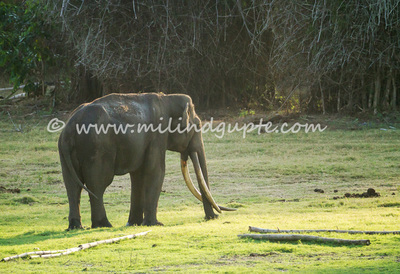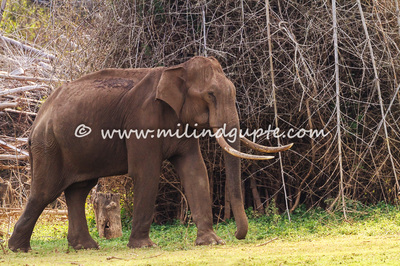|
Indian Jungle Safari & the Canon 200-400 F4L IS lens
I can’t think of a better place than the Indian Jungles to try out the Canon 200-400 F4L IS lens. This March I was in India for some work and decided to steal some time out in the Indian Jungles. My mate organised a trip to a few jungles in South India. The animals we would expect to see were, Elephants Tiger, Leopard, Gaur, Deer [ Sambar & Chital] Wild dog, Wild Boar, Crocodiles and birds and other lesser mammals. I decided to carry only 2 main lenses the 70-200 & the 200-400 with a wide angle just in case. In the field I almost found no use for the 70-200 lens. One of my bodies had the wide angle attached to it and the other had the Canon EF 200-400 F4 is lens on it. I used the Canon 200-400 F4L IS lens most of the time [ almost 95%] and the wide angle for just a bit of scenery and only when an elephant decided to charge us. I had no trouble carrying the Canon 200-400 F4L IS lens with the 7D attached in it’s case on board international flights and domestic flights in India. That was my cabin baggage and I carried the other body with the 70- 200 attached and the wide angle lens in a small camera bag. I carried both the bags and was never questioned anywhere. The smaller camera bag was chosen for its looks and indeed looked like a camera bag whereas the lens case for the bigger lens looked more like a backpack. The chargers and other stuff was in a hard suitcase which I used to check in. March is the beginning of summer in India and the landscape was going to be dry and warm. The mornings were going to be cool and the day warm that meant I would not have to carry extra warm clothing [ Indian winters can be cold depending where you are in India and morning drives in open 4wd vehicles are freezing] South India is known for its Elephants and I was lucky to sight some good tuskers. Some of the places you can pay extra and hire an open 4wd all for yourself whereas in other places you have to share with other tourists and some places it is only by 20 seater bus that you can venture into the forest. You have to be lucky to get good pictures as the bus drivers do not shut the engine. We reached Kabini River lodges in time for lunch and the afternoon safari. The safaris usually last for a couple of hours. At Kabini open 4wd vehicles are used they are open on the side with a soft top. Besides the driver you have a guide and they are in front. Depending on the make of the vehicle used and how busy it is you have 4-8 people per vehicle. You are allocated a vehicle and the vehicle is allocated a route within the jungle and it has to stick to it. The driver and the guide are very keen to spot the big cats [ Leopard and the tiger] for you and tend to ignore the lesser animals. As this was my first venture in the Indian Jungles with the new Canon 200-400 F4L IS lens I was interested in everything and anything that moved. Fellow passengers indicated that they were interested in big cats only . The resort management had made sure that there were only serious photographers in our vehicle, but they were locals and frequent visitors to the jungle. This is where it becomes problematic. I was wanting to photograph deer, gaur, elephants monkeys birds etc and others were not. I made it clear that I was interested in all wildlife and would ask the vehicle to stop at a good photo opportunity. These jungles are infested with lantana which make spotting and photographing animals very difficult besides making a poor background. Luckily that afternoon we had the route which took us along the backwaters of Kabini. Initially the sighting was not good as the driver kept on speeding looking for big cat signs.As the sun started going down the animals started to come out in numbers to feed on the green grass on the banks. Elephants were out in numbers. The tuskers were by themselves and usually far away or on the other bank in poor light. I would request the vehicle to stop and commence shooting much to the chagrin of others. I managed to get a few elephant family shots, a few tuskers [ photos below] and some gaur. [more about them in the next post.] The elephant families had babies with them and it was interesting to watch them keep the baby always between two adults when moving, protecting the babies from predators. They were at a distance from us and the females showed no sign of unease or aggression. In another jungle we had the matriarch demonstrate and charge our vehicle we we inadvertently got too close. Important to note is I used the Canon 200-400 F4L IS more than 95% of the time even for big animals like the elephants, and my 17-85 kit lens which I had carried just in case, rest of the time attached to the other body. I never used the 70-200 on this trip. Though I carried my beloved monopod I used homemade bean bag filled with plastic? beans/granules. I bought these in India for around $2.75 AUD a kilo. They are lighter than grain/rice etc and not affected by rain or water, also you don’t have rats or mice making holes in your bean bag at night trying to get at the rice in your bag. Watch this space - I will be posting about the other jungles and more animals & photos in the following weeks.
0 Comments
|
Archives
October 2017
Categories
All
|











 RSS Feed
RSS Feed
